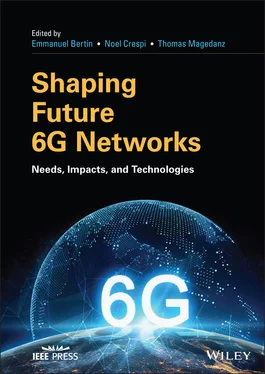Shaping Future 6G Networks
Здесь есть возможность читать онлайн «Shaping Future 6G Networks» — ознакомительный отрывок электронной книги совершенно бесплатно, а после прочтения отрывка купить полную версию. В некоторых случаях можно слушать аудио, скачать через торрент в формате fb2 и присутствует краткое содержание. Жанр: unrecognised, на английском языке. Описание произведения, (предисловие) а так же отзывы посетителей доступны на портале библиотеки ЛибКат.
- Название:Shaping Future 6G Networks
- Автор:
- Жанр:
- Год:неизвестен
- ISBN:нет данных
- Рейтинг книги:3 / 5. Голосов: 1
-
Избранное:Добавить в избранное
- Отзывы:
-
Ваша оценка:
- 60
- 1
- 2
- 3
- 4
- 5
Shaping Future 6G Networks: краткое содержание, описание и аннотация
Предлагаем к чтению аннотацию, описание, краткое содержание или предисловие (зависит от того, что написал сам автор книги «Shaping Future 6G Networks»). Если вы не нашли необходимую информацию о книге — напишите в комментариях, мы постараемся отыскать её.
Discover the societal and technology drivers contributing to build the next generation of wireless telecommunication networks Shaping Future 6G Networks: Needs, Impacts, and Technologies
Shaping Future 6G Networks
Shaping Future 6G Networks — читать онлайн ознакомительный отрывок
Ниже представлен текст книги, разбитый по страницам. Система сохранения места последней прочитанной страницы, позволяет с удобством читать онлайн бесплатно книгу «Shaping Future 6G Networks», без необходимости каждый раз заново искать на чём Вы остановились. Поставьте закладку, и сможете в любой момент перейти на страницу, на которой закончили чтение.
Интервал:
Закладка:
Juan A. CabreraDeutsche Telekom Chair of Communication Networks Technische Universität Dresden Dresden Germany
Renato L.G. CavalcanteTU Berlin/Heinrich Hertz Institute Berlin Germany
Marius CoriciFraunhofer FOKUS Berlin Germany
Noel CrespiIMT, Telecom Sud Paris Institut Polytechnique de Paris Paris France
Isabelle DabadieLaboratoire de recherche en sciences de gestion Panthéon‐Assas (LARGEPA) Université Paris 2 Panthéon‐Assas Paris France
Christian DeppeChair of Communication Engineering Technische Universität München Munich Germany
Marco Di RenzoCNRS, Centrale Supelec, L2SUniversity of Paris‐Saclay Gif‐sur‐ Yvette France
Frank H. P. FitzekDeutsche Telekom Chair of Communication Networks. Technische Universität Dresden Dresden Germany
Marco GiordaniDepartment of Information Engineering University of Padova Padova Italy
Imen Grida Ben YahiaOrange Innovation Châtillon France
Thomas HeynHead of Mobile Communications Group Broadband and Broadcast Department Fraunhofer IIS Erlangen Germany
Alexander HofmannDepartment RF Sat Com Systems Fraunhofer Institute for Integrated Circuits Erlangen Germany
Jinri HuangChina Mobile Research Institute Beijing China
Chih‐Lin IChina Mobile Research Institute Beijing China
Christian JacquenetOrange Innovation Cesson‐Sévigné France
Alexander KellerNVIDIA Berlin Germany
Markus LandmannElectronic Measurements and Signal Processing (EMS) Department Fraunhofer Institute for Integrated Circuits IIS. Ilmenau Germany
Andres LayaEricsson Research Stockholm Sweden
Thomas MagedanzFraunhofer FOKUS Berlin Germany
Marie‐José MontpetitMontreal Canada
Robert MüllerElectronic Measurements and Signal Processing (EMS) Department Fraunhofer Institute for Integrated Circuits IIS. Ilmenau Germany Concordia University
Akihiro NakaoThe University of Tokyo Tokyo Japan
Zhisheng NiuTsinghua University Beijing China
Michele PoleseInstitute for the Wireless Internet of Things Northeastern University Boston MA USA
Sahana RaghunandanDepartment RF Sat Com Systems Fraunhofer Institute for Integrated Circuits Erlangen Germany
Leszek RaschkowskiWireless Communications and Networks Department Fraunhofer Heinrich Hertz Institute HHI Berlin Germany
Guy RedmillRedmill Communications Ltd London UK
Rafael F. SchaeferChair of Communications Engineering and Security University of Siegen Siegen Germany
Christian ScheunertChair of Communication Theory Technische Universität Dresden Dresden Germany
Henning SchulzrinneColumbia Univeristy New York USA
Sławomir StańczakTU Berlin/Heinrich Hertz Institute Berlin Germany
Peter StuckmannEuropean Commision Brussels Belgium
Soma VelayuthamNVIDIA Santa Clara CA USA
Marc VautierOrange Innovation Cesson‐Sévigné France
David Zhe LouHuawei Technologies Düsseldorf GmbH Munich Germany
Sheng ZhouTsinghua University Beijing China
Michele ZorziDepartment of Information Engineering, University of Padova Padova Italy
Forewords
Henning Schulzrinne, Columbia University, USA
The first few iterations of cellular networks, 1G through 3G, were largely telephone networks with mobility added on, including the choice of addressing through telephone numbers, signaling through SS7, and emphasis on interoperable voice services. 4G and 5G started the transition to an Internet‐driven architecture, with remnants of the old architecture still clearly visible. But beyond the protocol choices, all existing generations were largely driven by the assumption that networks are operated by a relatively small number of carriers, typically with at least a nationwide service footprint, reliant on licensed spectrum and an assumption of mutual trust. 5G has started to focus more attention on using the same radio technology for both industrial and consumer networks, but the large‐carrier mindset still pervades the design, with a tightly‐coupled set of protocols and entities. This tightly‐coupled model provides some advantages; it bundles a consistent set of features and technologies designed and packaged to work together, relying on a strict user management and authentication framework. However, this model comes also with drawbacks, such as the lack of flexibility to adapt to new technologies or use‐cases, and having to rely on three or at most four carriers in most countries.
Since 3G, branding mobile network generations have had both a technical and a consumer marketing role. The generations provided checkpoints for equipment vendors, and made advances in technology that’s otherwise largely invisible to consumers relevant and marketable. 5G is probably the first iteration where a transition in technology standards became a matter of national pride and an indicator of national or regional competitiveness, with promises of increases in consumer and societal welfare that may be hard to deliver. However, as the digital divide during COVID‐19 illustrated, universal access to affordable broadband, typically at home, mattered more than higher 5G speeds in the downtown business districts and digital transformation is not assured by having nationwide 5G. Thus, technologists and policy makers working on post‐5G efforts should be careful in calibrating expectations, given that wireless network technology may not be the most significant hurdle that prevent addressing key societal challenges.
It seems likely that we will see a much larger variety of operational scenarios in the next decade, from traditional vertical‐integrated carriers to disaggregated carriers and to private or federated enterprise networks. Any future network architecture needs to be sufficiently modular so that it can scale down to unmanaged home networks and scale up to networks where participants have limited trust in each other. This suggests a much more flexible and much simpler authentication and roaming model than we have had in previous network generations. Here, 6G can probably learn from another wireless technology where “generations” have played less of a role – ubiquitous Wi‐Fi.
Developments for IoT during the 5G standardization and deployment phase may also hold lessons that encourage predictive modesty for 6G. Rather than being the universal network that connects billions and billions of IoT devices to create “smart” buildings and cities, cheap home Wi‐Fi and new low‐cost technologies like LoRa, leveraging unlicensed spectrum, have come to dominate, with carrier IoT offerings falling short of expectations – indeed, retaining boring and obsolete 2G often seems to draw more interest than new 5G ultralow latency capabilities.
Previous generations of cellular networks offered their per‐user speed as the headline advantage, but 5G is already showing the limitations of that approach, as few mobile applications are likely to be built that will rely on 1 Gb/s or above speeds. Thus, the key metrics will not be per‐user throughput or latency, but cost per base station month, governing deployment cost in low‐density areas, and cost per bit delivered, i.e., primarily operational costs. Environmental metrics such as energy consumption or electromagnetic fields (EMF) must also be considered. For many years, capital equipment has only accounted for about 15% of revenues of most carriers, i.e., the vast majority of expenses are operational. This argues for a simple, self‐managed, and robust network, with as many commodity components and protocols as possible and as much re‐use of available fiber access networks as possible, rather than infinite configurability or elaborate QoS mechanisms. The largest opportunities for improved operational efficiency and reduced complexity are in the control plane, not the data plane, relying for that on machine learning and automation technologies as detailed in this book. However, since 6G will serve as infrastructure, with concomitant reliability expectations, robustness, predictability and explainability of any use of machine learning will be more important than squeezing out the last percentage points of efficiency.
Читать дальшеИнтервал:
Закладка:
Похожие книги на «Shaping Future 6G Networks»
Представляем Вашему вниманию похожие книги на «Shaping Future 6G Networks» списком для выбора. Мы отобрали схожую по названию и смыслу литературу в надежде предоставить читателям больше вариантов отыскать новые, интересные, ещё непрочитанные произведения.
Обсуждение, отзывы о книге «Shaping Future 6G Networks» и просто собственные мнения читателей. Оставьте ваши комментарии, напишите, что Вы думаете о произведении, его смысле или главных героях. Укажите что конкретно понравилось, а что нет, и почему Вы так считаете.












